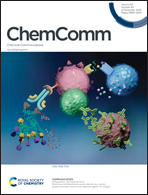Time-gated fluorescence signalling under dissipative conditions†
Abstract
Precise control over specific functions in the time domain is ubiquitous in biological systems. Here, we demonstrate time-gated fluorescence signalling under dissipative conditions exploiting an ATP-fueled self-assembly process. A temporal ATP-concentration gradient allows the system to pass through three states, among which only the intermediate state generates a fluorescent signal from a hydrophobic dye entrapped in the assemblies. The system can be reactivated by adding a new batch of ATP. The results indicate a strategy to rationally programme the temporal emergence of functions in complex chemical systems.



 Please wait while we load your content...
Please wait while we load your content...